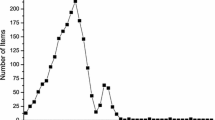Abstract
Finding the most interesting correlations among items is essential for problems in many commercial, medical, and scientific domains. Our previous work on the maximal fully-correlated itemset (MFCI) framework can rule out the itemsets with irrelevant items and its downward-closed property helps to achieve good computational performance. However, to calculate the desired MFCIs in large databases, there are still two computational issues. First, unlike finding maximal frequent itemsets which can start the pruning from 1-itemsets, finding MFCIs must start the pruning from 2-itemsets. When the number of items in a given dataset is large and the support of all the pairs cannot be loaded into the memory, the IO cost (\(O(n^2)\)) for calculating correlation of all the pairs can be very high. Second, users usually need to try different correlation thresholds for different desirable MFCIs. Therefore, the cost of processing the Apriori procedure each time for a different correlation threshold is also very high. Consequently, we proposed two techniques to solve these problems. First, we identify the correlation upper bound for any good correlation measure to avoid unnecessary IO query for the support of pairs, and make use of their common monotone property to prune many pairs even without computing their correlation upper bounds. In addition, we build an enumeration tree to save the fully-correlated value for all the MFCIs under a given initial correlation threshold. We can either efficiently retrieve the desired MFCIs for any given threshold above the initial threshold or incrementally grow the tree if the given threshold is below the initial threshold. Experimental results show that our algorithm can be an order of magnitude faster than the original MFCI algorithm.







Similar content being viewed by others
References
Agrawal R, Imieliński T, Swami A (1993) Mining association rules between sets of items in large databases. In: SIGMOD ’93: Proceedings of the ACM SIGMOD international conference on management of data. ACM, New York, pp 207–216
Bayardo RJ, Jr. (1998) Efficiently mining long patterns from databases. In: SIGMOD ’98: Proceedings of the 1998 ACM SIGMOD international conference on management of data. ACM, New York, pp 85–93
Brin S, Motwani R, Silverstein C (1997) Beyond market baskets: Generalizing association rules to correlations. In: SIGMOD ’97: Proceedings ACM SIGMOD international conference on management of data. ACM, New York, pp 265–276
Brin S, Motwani R, Ullman JD, Tsur S (1997) Dynamic itemset counting and implication rules for market basket data. In: SIGMOD ’97: Proceedings of the ACM SIGMOD international conference on management of data. ACM, New York, pp 255–264
Burdick D (2001) Mafia: A maximal frequent itemset algorithm for transactional databases. In: ICDE ’01: Proceedings of the 17th international conference on data engineering. IEEE Computer Society, Washington, DC, p 443
Duan L, Khoshneshin M, Street W, Liu M (2013) Adverse drug effect detection. IEEE J Biomed Health Inf 17(2):305–311
Duan L, Street WN (2009) Finding maximal fully-correlated itemsets in large databases. In: ICDM ’09: Proceedings of the 9th international conference on data mining. IEEE Computer Society, Miami, pp 770–775
Duan L, Street WN, Liu Y (2013) Speeding up correlation search for binary data. Pattern Recognit Lett 34(13):1499–1507
Duan L, Street WN, Liu Y, Lu H (2014) Community detection in graphs through correlation. In: The 20th ACM SIGKDD conference on knowledge discovery and data mining (accepted)
Duan L, Street WN, Liu Y, Xu S, Wu B (2014) Selecting the right correlation measure for binary data. ACM transactions on knowledge discovery from data (accepted)
Dunning T (1993) Accurate methods for the statistics of surprise and coincidence. Comput Linguist 19(1):61–74
Geng L, Hamilton HJ (2006) Interestingness measures for data mining: A survey. ACM Comput Surv 38(3):9
Gouda K, Zaki MJ (2005) Genmax: An efficient algorithm for mining maximal frequent itemsets. Data Min Knowl Discov 11(3):223–242
Han J, Pei J, Yin Y (2000) Mining frequent patterns without candidate generation. In: SIGMOD ’00: Proceedings of the 2000 ACM SIGMOD international conference on management of data. ACM, New York, pp 1–12
Jermaine C (2005) Finding the most interesting correlations in a database: How hard can it be? Inf Syst 30(1):21–46
Liu M, Hinz ERM, Matheny ME, Denny JC, Schildcrout JS, Miller RA, Xu H (2013) Comparative analysis of pharmacovigilance methods in the detection of adverse drug reactions using electronic medical records. J Am Med Inform Assoc 20(3):420–426
Mohamed MH, Darwieesh MM (2013) Efficient mining frequent itemsets algorithms. Int J Mach Learn Cybern. doi:10.1007/s13042-013-0172-6
Omiecinski ER (2003) Alternative interest measures for mining associations in databases. IEEE Trans Knowl Data Eng 15(1):57–69
Piatetsky-Shapiro G (1991) Discovery, analysis, and presentation of strong rules. AAAI/MIT Press, Cambridge
Tan P-N, Kumar V, Srivastava J (2004) Selecting the right objective measure for association analysis. Inf Syst 29(4):293–313
Tew C, Giraud-Carrier C, Tanner K, Burton S (2014) Behavior-based clustering and analysis of interestingness measures for association rule mining. Data Min Knowl Discov 28(4):1004–1045
Vo B, Le T, Coenen F, Hong T-P (2014) Mining frequent itemsets using the n-list and subsume concepts. Int J Mach Learn Cybern. doi:10.1007/s13042-014-0252-2
Zhou W, Zhang H (2013) Correlation range query for effective recommendations. World Wide Web. doi:10.1007/s11280-013-0265-x
Author information
Authors and Affiliations
Corresponding author
Rights and permissions
About this article
Cite this article
Duan, L., Street, W.N. Speeding up maximal fully-correlated itemsets search in large databases. Int. J. Mach. Learn. & Cyber. 7, 741–751 (2016). https://doi.org/10.1007/s13042-014-0290-9
Received:
Accepted:
Published:
Issue Date:
DOI: https://doi.org/10.1007/s13042-014-0290-9




